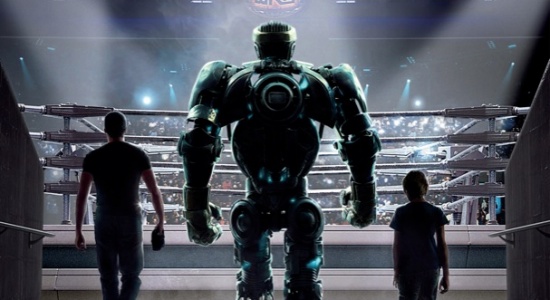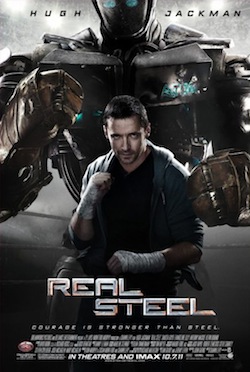 There’s a surprising delicacy with which Real Steel acquaints us with the near-future world of the film, and the characters that will struggle in it. In a future filled with advanced robots and giant electronic fighting titans, Hugh Jackman’s hustling screw-up of a (human) character Charlie is introduced out in the breezy midwest accompanied by a rusty junk-bot that he pits against bulls to make a few bucks. Right away the golden fields shot beautifully with the sophisticated mix of animatronic and CGI robot effects juxtaposed against them suggest this film may end up being something more special than your average high-concept blockbuster.
There’s a surprising delicacy with which Real Steel acquaints us with the near-future world of the film, and the characters that will struggle in it. In a future filled with advanced robots and giant electronic fighting titans, Hugh Jackman’s hustling screw-up of a (human) character Charlie is introduced out in the breezy midwest accompanied by a rusty junk-bot that he pits against bulls to make a few bucks. Right away the golden fields shot beautifully with the sophisticated mix of animatronic and CGI robot effects juxtaposed against them suggest this film may end up being something more special than your average high-concept blockbuster.
Don’t worry, just give it time.
Right away it’s worth acknowledging that for all the twisted scrap metal, Real Steel has a real beating heart to it, and a genuine love for some of its characters. Shawn Levy brings a sharp, straightforward eye for delivering story, action, and character beats to this film, and ultimately when it betrays itself and devolves into the thoughtless, empty spectacle that any cynic would have predicted, it is to Levy’s credit that the film is endowed with a momentum that pushes it through. Make no mistake though, Real Steel is a typically pandering blockbuster that plows through a lot of moments of surface emotion without ever truly doing right by its characters or its world. It does manage to set a low thematic bar for itself that it eventually coasts under, but in the process it sets up and thoughtlessly discards big characters and ideas, the results of which are all the more disappointing because of the displayed potential.
Real Steel takes place in an America in which nearly twenty years have passed since the present day, where video games and athletics have merged together to form a product that combines the corporeal violence of boxing with the modding sensibilities of computer tech. In this world robots long ago took over fisticuffs in the ring at every level, from the highly corporate robot fighting leagues to the underground cash brawls. It’s unclear if other sports have evolved similarly (the film is not much for world-building beyond very obvious cues), but there is certainly a huge culture devoted to robot fighting enriched by many years of history. Charlie is a victim of this cultural shift, having been a boxer full of potential whose star faded along with the idea of human fighting itself. He now ekes out a living borrowing cash and engaging in gimmick robot fights when he learns his estranged son Max (played by the energetic and charismatic Dakota Goyo) has recently lost his mother.
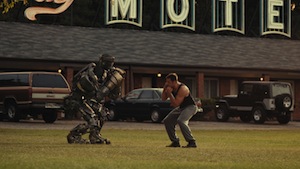 The film exploits the innate charm of Hugh Jackman by pushing his character pretty far into the “terrible human being” end of the spectrum, to the point that he ostensibly sells his custody rights to the boy’s wealthy Aunt and Uncle. The arrangement has the sharp-tongued and strong-willed kid sticking around over the summer though, so the two get wrapped up and are soon at odds. This relationship works, and it’s the reason the film isn’t a completely insulting failure. For all of its fumbled themes and shallow spectacle, the chemistry between Jackman and Goyo is undeniable, and the characters are clearly rendered. It’s the struggle for Max to convince Charlie that he can be a father if he’ll only try that gives rhythm to the film’s aforementioned beating heart.
The film exploits the innate charm of Hugh Jackman by pushing his character pretty far into the “terrible human being” end of the spectrum, to the point that he ostensibly sells his custody rights to the boy’s wealthy Aunt and Uncle. The arrangement has the sharp-tongued and strong-willed kid sticking around over the summer though, so the two get wrapped up and are soon at odds. This relationship works, and it’s the reason the film isn’t a completely insulting failure. For all of its fumbled themes and shallow spectacle, the chemistry between Jackman and Goyo is undeniable, and the characters are clearly rendered. It’s the struggle for Max to convince Charlie that he can be a father if he’ll only try that gives rhythm to the film’s aforementioned beating heart.
To look beyond these two characters is to start seeing how thin this film and its world are though. After another disastrous fight in which Charlie loses his best chance at being relevant in the fighting world again, the two characters begin to bond over the prospects of a robot Max stumbles across, forgotten and buried in a scrapyard. An early fight robot model, “Atom” is a sparring bot built to take hits and imbued with a function that allows him to shadow a person or robot in his field of view. It’s suggest this is a rare function– apparently there’s no futuristic bit-torrent for fighting robot firmware. Naturally, Atom becomes the center of a lot of seemingly magic robot repair (engineering and fabrication in the film is treated with sub-LEGO sophistication) and after a shaky first fight, is treated to quite the montage of succes. Ultimately it all boils down to a match-up of Atom the scrappy underdog, with the massive and massively powerful Zeus– a triumph of engineering and programming that fights autonomously and adapts to any opponent. A keen film eye might predict that Atom will ultimately be revealed as an early effort of the mysterious Asian man who designed Zeus (it would explain the magic sentience of Atom) but one shouldn’t hold their breathe for the script to make a connection that logical. We’re getting ahead of ourselves though.
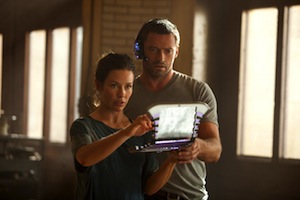 This is undoubtedly a family film, and one not aiming for much appreciation of basic logic. Ultimately enjoying the film means rolling along with the idea that a kid could essentially dig up a 70s Chevy Impala and turn around to win the Forumla 1 world championship. All things being equal that’s not a remarkable suspension of disbelief for a kid’s film, but it’s not ultimately servicing a more well thought out thematic point. For all the success of the father-son chemistry, the film never gets a handle on the relationship between father, son, and robot. In a world of outlandish designs and impersonal hulks of metal, Atom is an anthropomorphized bot that sports a smiling face and is clearly suggested to be if not fully-sentient, a machine with some kind of thoughts or feelings. His connection to Max is forged through a cute scene in which they train together and share a moment of understanding, and yet this is almost immediately abandoned as the film refocuses on father and son. Since Atom is at first controlled by remote, and then voice commands, and then the shadow function, there is never a defined dynamic between the three of them, which makes the whole feeling of triumph and perseverance murky.
This is undoubtedly a family film, and one not aiming for much appreciation of basic logic. Ultimately enjoying the film means rolling along with the idea that a kid could essentially dig up a 70s Chevy Impala and turn around to win the Forumla 1 world championship. All things being equal that’s not a remarkable suspension of disbelief for a kid’s film, but it’s not ultimately servicing a more well thought out thematic point. For all the success of the father-son chemistry, the film never gets a handle on the relationship between father, son, and robot. In a world of outlandish designs and impersonal hulks of metal, Atom is an anthropomorphized bot that sports a smiling face and is clearly suggested to be if not fully-sentient, a machine with some kind of thoughts or feelings. His connection to Max is forged through a cute scene in which they train together and share a moment of understanding, and yet this is almost immediately abandoned as the film refocuses on father and son. Since Atom is at first controlled by remote, and then voice commands, and then the shadow function, there is never a defined dynamic between the three of them, which makes the whole feeling of triumph and perseverance murky.
That lack of a consistent set-up is important. At one point it seems to be that Charlie will ultimately pilot the bot, while Max connects with Atom as a friend, expressing the connection in a dance routine the boy and the bot do before fights. Silly as that sounds, it suggests a clear harmony in which all three of them play a part and contribute to a larger whole. Those set-ups are abandoned though, and it comes down to Max screaming on the sides while Charlie remotely pilots the bot, or leads him via pantomime on the sidelines. Why the film trashes a set up that allows a kid to succeed in the big leagues because all of the fighters are ultimately reduced to behind-the-remote skill is beyond me. It does make sense that Atom’s shadow function would ultimately require Charlie to literally “fight for” Max when the remote control systems fail, but the clear opportunity for that hand off is completely wasted. Even worse, the idea of the “shadow function” gives Charlie an opportunity to take charge for a while and prove himself as a brave fighter, while still giving Atom hid due. Had the film setup a climax in which Atom’s view of Charlie is blocked (a logistical problem that’s just ignored anyway), then it would have given Atom a chance to “wake up” and finish the fight himself. A wonderful moment in which this robot, which has been set up as a thinking creature, could rise up and pay off its own arc while organically paying off all of Max and Charlie’s investment in him would have been wonderful. Instead you get the same final battle montage and finish you’ve seen a dozen times.
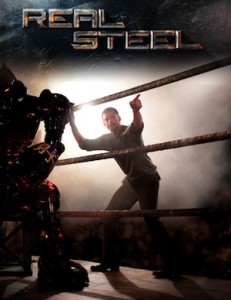 This core failure of one its important characters and the missed opportunities mar what otherwise would have been an unambitious but generally competent family sports spectacle. Had the film pulled off a clear theme to back its triumph, it would have been easy to ignore the lazy visualization of a future in which no corporate logos have changed in 20 years, cars are all clean current models, computers and cellphones have advanced only as far as concept art from six years ago, and Beats By Dre headphones are still being manufactured as they look right now. Had the film not failed a major character so harshly, it would be easier to write off a useless character like Charley’s exposition-spouting love interest and her apparently sacred, and yet completely unpatronized gym. Had the film stuck to logic that at least consistently served the trio’s dynamic, it wouldn’t be so annoying to accept a world with so little to say about (and such a shallow understanding of) technology and video games. Alas the script falls flat on all these levels, and it’s only by virtue of the stellar performances and sophisticated effects that the film almost, kinda works. Unfortunately Levy’s understated and effective capturing of the story and action flattens out when the story starts to climax into a snowballing mess of cliches.
This core failure of one its important characters and the missed opportunities mar what otherwise would have been an unambitious but generally competent family sports spectacle. Had the film pulled off a clear theme to back its triumph, it would have been easy to ignore the lazy visualization of a future in which no corporate logos have changed in 20 years, cars are all clean current models, computers and cellphones have advanced only as far as concept art from six years ago, and Beats By Dre headphones are still being manufactured as they look right now. Had the film not failed a major character so harshly, it would be easier to write off a useless character like Charley’s exposition-spouting love interest and her apparently sacred, and yet completely unpatronized gym. Had the film stuck to logic that at least consistently served the trio’s dynamic, it wouldn’t be so annoying to accept a world with so little to say about (and such a shallow understanding of) technology and video games. Alas the script falls flat on all these levels, and it’s only by virtue of the stellar performances and sophisticated effects that the film almost, kinda works. Unfortunately Levy’s understated and effective capturing of the story and action flattens out when the story starts to climax into a snowballing mess of cliches.
It’s unfortunate that such a silly premise as a Rock ‘Em, Sock ‘Em Robots movie played straight was machined into a film that empowered such effective performances and lovely collaborations of practical and digital effects, and yet ultimately fails so fundamentally. That it actually cares about character and theme is even more disappointing because a better movie seems so within reach. While the momentum of this movie may convince many that it’s already in front of us, there is a film based on this idea –perhaps a few drafts away or a few rewrites removed from what was ultimately shot– that is genuinely great. Real Steel isn’t it. It’ll get the kids clapping though.
Rating: 




Out of a Possible 5 Stars
